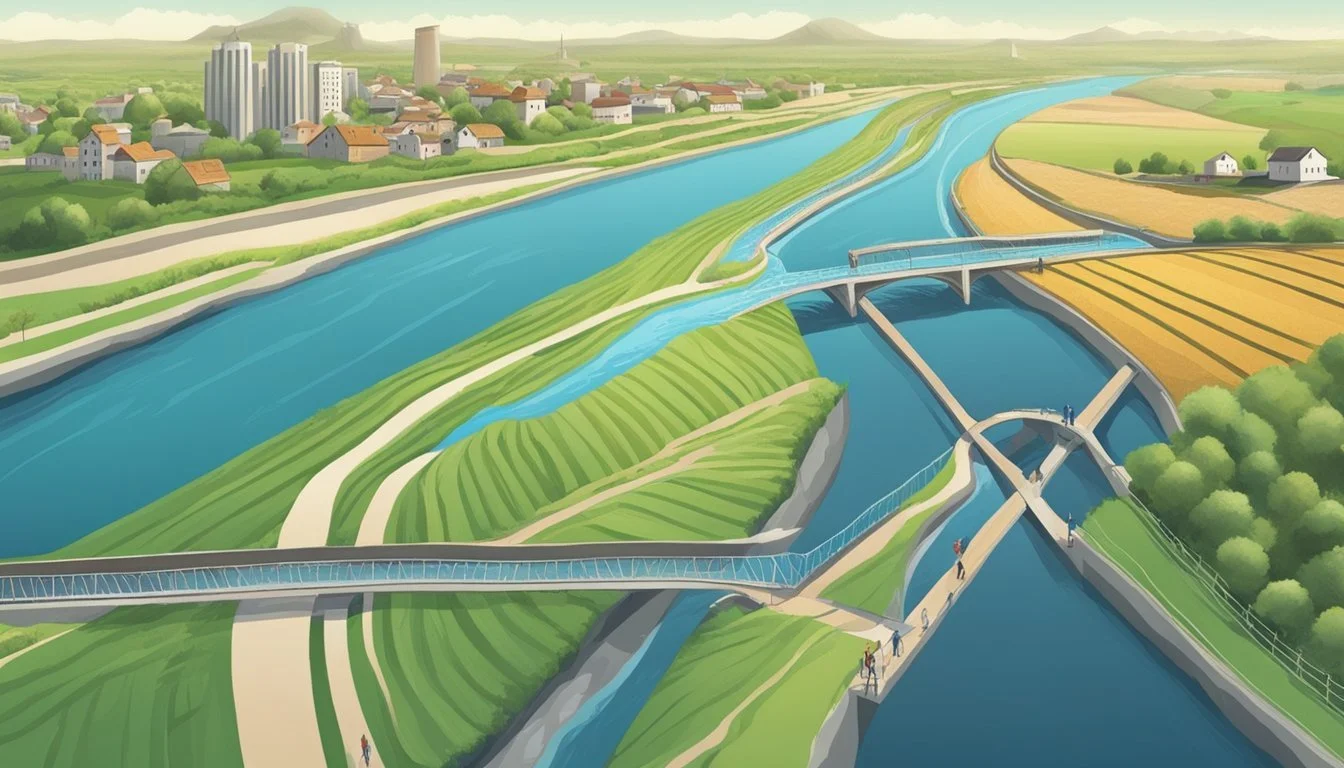Water Rights in Utah
Navigating Legalities and Resource Management
Water rights in Utah are a complex and highly-regulated aspect of the state's legal framework, due to the arid climate and the scarcity of water resources. The Utah Division of Water Rights oversees the appropriation and allocation of water, ensuring that the distribution of this precious resource is conducted fairly and in accordance with state laws. It operates within the Department of Natural Resources and is tasked with balancing the needs of various water users, including agricultural, industrial, municipal, and environmental stakeholders.
The state has a history of legal structures for managing water use, reflecting the importance of water in the region's development. Utah's water rights system is based on the doctrine of prior appropriation, commonly summarized as "first in time, first in right." This system allocates water to those who have historically put it to beneficial use. However, as the state faces growing challenges such as increased demand and environmental stresses, legislation and policy continue to evolve. Recently, changes in water law have allowed for more flexibility, including measures to protect natural lands like the Great Salt Lake through securing water rights and in-stream flow leases.
As Utah continues to grow, so does the scrutiny of its water rights policies and practices. The establishment of water judges and the progress of water rights adjudication, such as the ongoing Utah Lake Jordan River Water Rights General Adjudication, exemplify the state's efforts to carefully manage this vital resource. These judicial processes aim to resolve disputes and clarify water rights, ensuring that the system is equitable and capable of addressing present and future demands.
Overview of Utah Water Rights
Utah's framework for water rights is based on the doctrine of prior appropriation, commonly encapsulated in the axiom "first in time, first in right." This principle establishes that those who first put water to beneficial use have senior rights over others who may seek to use the water later. The State Engineer plays a central role in administering water rights, ensuring that they align with Utah water law.
The Utah Division of Water Rights outlines key components of what constitutes a water right:
Nature of Right: In Utah, a water right is treated as real property, similar to owning land. However, unlike owning a parcel of land, a water right grants the holder the ability to use the water rather than own the water itself.
Quantification: Rights are quantified by a defined volume, usually in acre-feet, or a flow rate, such as cubic feet per second (cfs).
Usage: The right specifies a place of use, point of diversion, and type of beneficial use, such as irrigation, domestic needs, or industrial applications.
According to Utah law, all waters are public property, and individuals or entities must obtain a legitimate water right to divert and beneficially use water. Simply owning land adjacent to a water source does not automatically confer water rights.
The process of acquiring a new water right consists of submitting an application to the Division of Water Rights, which is then reviewed based on criteria like availability of unappropriated water, potential interference with existing rights, and considerations for the conservation of water resources.
Utah water law demands that water rights holders put their rights to beneficial use. Failure to demonstrate such use can result in the forfeiture of the rights, underscoring the state's emphasis on the efficient and diligent use of its precious water resources.
Legal Framework
Utah's water rights system is codified under Title 73, which provides the foundational legal framework for water law and the management of water resources within the state. Key entities involved in this framework include the State Engineer and water right holders, with jurisdictional guidance and legal counsel impact on the application and enforcement of these laws.
Water Law and Use
In Utah, water law is governed by the doctrine of Prior Appropriation — "first in time, first in right" — which prioritizes water rights based on the chronological order of their claims. A water right is a legal entitlement to use water from a natural resource, such as a river or groundwater, for a beneficial purpose. These rights are tied to real property, but can be sold or leased separately from the land.
State Oversight
The Utah Division of Water Rights, headed by the State Engineer, oversees the appropriation and distribution of water. This entity operates under the Department of Natural Resources to ensure that water use aligns with state policies. They are also responsible for maintaining records of all water rights and their usage, and provide vital information to consumers and policymakers alike.
Property and Ownership
Within the state's legal framework, water rights are considered a type of real property, which can be bought, sold, and transferred, subject to certain regulations. Ownership of water rights is deeply intertwined with land ownership, yet it is distinct in that water rights can be detached and managed independently of the land. Utah law stipulates the processes and requirements for transferring these rights, often requiring approval from the State Engineer.
Beneficial Use and Public Interest
Beneficial use is the cornerstone of Utah's water law, ensuring that water is used efficiently and not wasted. The state regards beneficial use as the measure and limit of a water right. Public interest also plays a role, where water use must not only serve the individual's interest but also the welfare of the community. Changes or disputes in water rights often necessitate the involvement of legal counsel due to the complex intersection between private rights and public needs.
Applying for Water Rights
In Utah, obtaining legal rights to use water involves specific application processes and adherence to state regulations. The Utah Division of Water Rights oversees these procedures, ensuring the appropriate use and distribution of water resources.
New Water Rights and Applications
Individuals or entities seeking to appropriate water in Utah must file an application with the Division of Water Rights. The process begins with the submission of a New Water Right Application, which includes a detailed plan of how the applicant intends to use the water beneficially. This may cover uses such as irrigation, domestic, or industrial purposes. The application must specify the quantity of water sought, the point of diversion, and the place of intended use.
Change Applications
For those who already hold an existing water right and wish to modify the use, place of use, point of diversion, or nature of use, a Change Application is required. This application must be submitted to the state, and is subject to public notice and potential objections. It is a necessary step to ensure the proposed changes do not impair existing rights or harm the public welfare.
General Adjudications
General adjudication is a court process meant to confirm all existing water right claims and identify unclaimed rights within a specific geographic area. It provides a formal opportunity for claims to be evaluated and either recognized or dismissed by the court. Participants in a general adjudication are required to submit their claim information to the state for assessment.
Buying and Selling Water Rights
To buy a water right in Utah, one must ensure the right is valid and eligible for transfer. The transaction often requires a change application if the buyer's intended use or place of use differs from the current terms of the water right. Sellers and buyers must adhere to state regulations and follow proper procedures to transfer the title of the water right effectively, maintaining the integrity of the State of Utah's water distribution and appropriation system.
Water Use Management
Managing water use in Utah involves a complex system of distribution, regulation, and utilization across various sectors, aligned with the state’s legal framework for water rights. It requires the coordination of the Division of Water Rights and the State Engineer to ensure the sustainable and lawful allocation of water resources.
Distribution and Regulation
In Utah, the Division of Water Rights oversees the distribution and regulation of water. This includes monitoring water use and ensuring compliance with established water laws. The State Engineer plays a pivotal role in this process by administering water rights and overseeing the division's programs, which aim to achieve an equitable and legal distribution of Utah's water resources.
Water Right Searches
Individuals and organizations in Utah can conduct water right searches to identify legal water rights, active water use parameters, and associated documentation. This search is essential for verifying the legitimacy of water rights claims and for understanding one's entitlements and responsibilities regarding water use. The Division of Water Rights provides a database where searches can be performed comprehensively.
Irrigation Practices
Irrigation is a significant water use in Utah, given its arid climate. Water rights are closely tied to irrigation practices, and users must adhere to specific water allocations to sustain agricultural productivity. Efficient irrigation techniques are encouraged to maximize water usage within the constraints of each granted water right.
Industrial and Energy Uses
Water in Utah also serves industrial and energy sectors, where the water is used for operations ranging from manufacturing to power generation. These uses are strictly regulated to balance economic benefits with environmental sustainability and public water needs. Companies operating in these sectors must obtain the appropriate water rights and comply with state regulations governing water usage.
Conservation and Sustainability
Utah's approach to water rights focuses on protecting the longevity and integrity of its water resources while balancing growth and maintaining natural ecosystems. Conservation efforts are critical to meet the needs of the present without jeopardizing future generations.
Protecting Water Resources
In Utah, safeguarding water resources is paramount. The state has implemented policies to ensure that water rights are sustainable. They're not only legally addressed but also practically managed to balance human usage with environmental protection. This includes careful monitoring and regulation of water use, encouraging efficient irrigation practices, and promoting the reuse and recycling of water whenever possible.
Natural Ecosystems
Natural ecosystems, including the Great Salt Lake and its surrounding wetlands, are vital to Utah's environmental health. The state recognizes that these ecosystems contribute significantly to local biodiversity and provide critical habitat for millions of migratory birds. Utah has passed resolutions like S.J.R. 14 to protect these ecosystems by negotiating and securing water rights necessary to preserve the natural state of these sovereign lands, ensuring their resilience against the impacts of development and climate change.
Responsible Developments
Utah advocates for responsible developments by enabling legislation that affects water rights and usage. A notable legislative shift addressed is Utah's "use it, or lose it" policy, which gave way to more progressive and conservation-oriented laws. For example, bills that support conservation efforts and facilitate funding for the Great Salt Lake are designed to align the state's economic growth with the prudent management of water resources, laying a path for sustainable development.
Administrative Procedures
Administrative procedures regarding water rights in Utah are comprehensive and structured, addressing various aspects from communication and licensing to policy enforcement. They are essential for managing water resources effectively within the state.
Contact and Communication
The Division of Water Rights manages contact and communication through the use of clear channels. Stakeholders can reach the Division via email notifications or through direct correspondence with the State Engineer's office. For enforcement-related queries, individuals can contact Jacob Olsen, the Enforcement Engineer, at jolsen or by mail to the Division's office in Salt Lake City.
Licensing and Certification
Water well drillers must obtain proper licensing to operate within Utah. Licensure signifies that drillers are certified and adhere to the state's rigorous standards. The licensing process is overseen by the Division of Water Rights, ensuring that all drillers meet the necessary qualifications and technical competencies. Details on licensure and certification can be found within the Division's Administrative Rules.
Policy and Enforcement
The executive director oversees water policy and its associated administrative procedures which are guided by the Division's rules. Enforcement is a critical component, ensuring compliance with these policies. For procedural details on enforcement, one can reference the Administrative Procedures for Enforcement Proceedings guide. This guide covers steps the Division takes in case of non-compliance, including the right to request a hearing.
Special Considerations
In managing Utah's water resources, particular attention must be given to balancing rural needs, urban growth, and environmental stewardship. Compliance with state regulations and coordination with regulatory bodies is essential for all stakeholders, including ranchers and developers.
Rural and Agricultural Concerns
In rural Utah, ranchers often depend on water rights for agricultural purposes. The state's Utah Division of Water Rights stipulates that individuals use water for beneficial purposes, like irrigation, which is crucial for crops and livestock. Proper documentation and legal compliance are necessary, especially during water shortages.
Urban Development
When planning to build a house or develop land in urban areas, developers must consider water availability and sustainability. Coordination with a regional office is required to ensure adherence to water rights legislation. Obtaining approvals from state agencies like the Utah Department of Natural Resources is imperative for urban development projects.
Wildlife and Recreation
The Division of Wildlife Resources and the Division of State Parks manage Utah's natural habitats and recreational areas. They oversee water usage for wildlife conservation and ensure water bodies within state parks are both protected and accessible for public enjoyment. Water rights allocations consider the impact on local ecosystems and recreational opportunities.
Frequently Asked Questions
Navigating the complexities of water rights in Utah involves understanding the administrative processes and legal frameworks. This section provides concise answers to common questions for individuals dealing with water rights in the state.
How are water rights allocated and administered in Utah?
Water rights in Utah are administered by the Utah Division of Water Rights, which operates under the doctrine of prior appropriation. This system allocates water based on a "first in time, first in right" priority where rights are granted in the order they were filed.
What is the process for proving beneficial use of water in Utah?
In Utah, individuals must demonstrate beneficial use, which means water must be used reasonably and without waste. Proving beneficial use involves submitting proof to the Division of Water Rights that the water is being put to its intended use as stated in the water right.
What should one consider before purchasing water shares in Utah?
Before purchasing water shares, it’s crucial to assess the reliability of the water source, understand water delivery systems, and be aware of associated fees and assessments. Legal advice is also recommended to navigate the complexities of water rights transfer.
Where can one find Utah water rights maps and associated documentation?
Utah water rights maps and documentation can be accessed through the Utah Division of Water Rights website, where individuals can find detailed information regarding water rights distribution and mapping tools.
How can a property owner in Utah verify ownership of water rights?
Property owners can verify water rights ownership by consulting the records maintained by the Utah Division of Water Rights. It's also recommended to seek professional assistance for thorough documentation review and confirmation.
What are the legal requirements for transferring water rights in Utah?
The transfer of water rights in Utah requires submitting a change application to the Division of Water Rights, with the legal requirements entailing proof of beneficial use, public notification, and potential hearings for contested cases.






